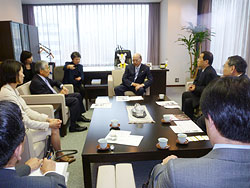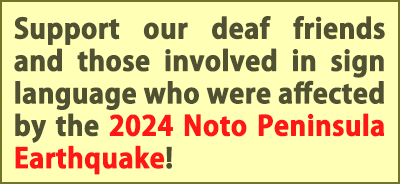Back to earthquake information
Article in English is below video.
On May 11, 2011, Chief Fujisaburo Ishino and General Manager Mitsuji Hisamitsu of the Central Headquarters for Disaster Relief for Deaf People in the Great East Japan Earthquake (Central HQ) had a meeting with Mr. Michisada Hirose, President of the National Association of Commercial Broadcasters in Japan (NAB). The meeting was coordinated by Councilor Tamayo Marukawa, who had been interested in the demands on the TV broadcasting regarding the disaster which had been made by the Japanese Federation of the Deaf (JFD) at the hearings of disability representatives held by political parties.
 Meeting with NAB (Click to enlarge) |
At the meeting, Mr. Ishino and Mr. Hisamatsu, showing various documents and photographs of TV programs in other countries, demanded that the TV broadcasters should include sign language and subtitles in the news programs to ensure that the persons who are Deaf or hard-of-hearing could have full access to information.
The Central HQ explained and demanded of the NAB:
- Most of the TV news programs today are broadcasted without sign language or subtitles, and thus the persons who are Deaf or hard-of-hearing find difficulties acquiring information. In the disaster caused by the great earthquake in March, they have been in a difficult situation in terms of getting necessary information. The broadcasters should therefore include sign language and subtitles in all of the news programs, so that the persons who are Deaf or hard-of-hearing could obtain information as well as other viewers.
- The government started sign language interpreting, for the first time in Japan, for the press conferences at the Prime Minister’s Office. In the news programs, however, almost all of the broadcasters do not televise the interpreter, who is obliged to sign at a distance from the speaker. On the other hand, in New Zealand, where they also experienced a great earthquake in February, a sign language interpreter always appears on the screen with the press secretary, because they stand side by side at the press briefings. Thus we suggest that you let an interpreter stand beside the speaker at the press conferences just as in New Zealand.
- Even in other countries such as Korea, Egypt, Syria, too, news programs are broadcasted with sign language interpreting. Japan is clearly far behind the world. You should start to include sign language interpreting and subtitles in all of the news programs as soon as possible.
And Mr. Hirose responded:
“I am afraid that we have not been ready yet for sign language interpretation in broadcast. But we should not give up, just by saying, ‘it is not possible for live news’. We hope to see what we can do, and maybe try to include sign language and subtitles in some programs, if not all at once, such as in the evening news. In the disaster of East Japan Great Earthquake, we find a lot of things that we, the media, had better improve. The government and municipalities are also investigating what the media should have done in such an emergency.”
“It would be helpful if you, as the JFD, could make out and hand in a report which would contain opinions of victims, cases of lacking information, situations in other countries.”


